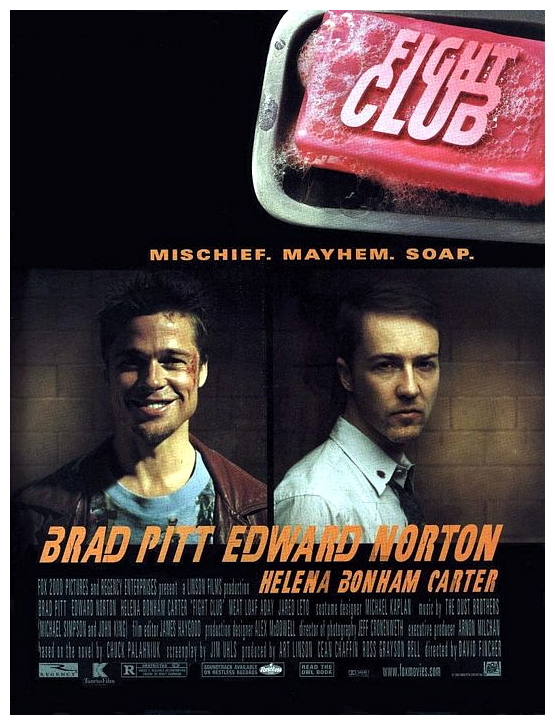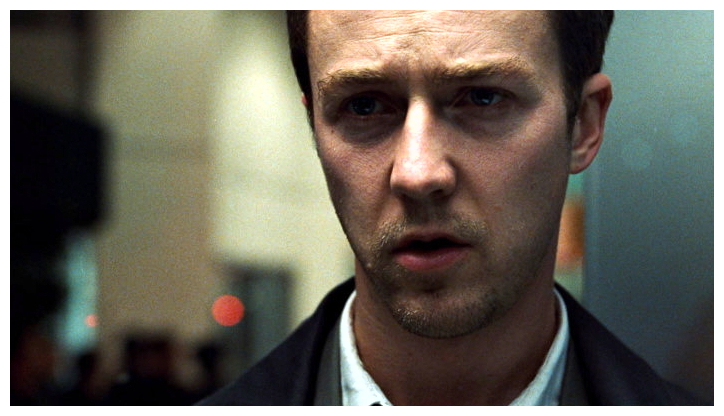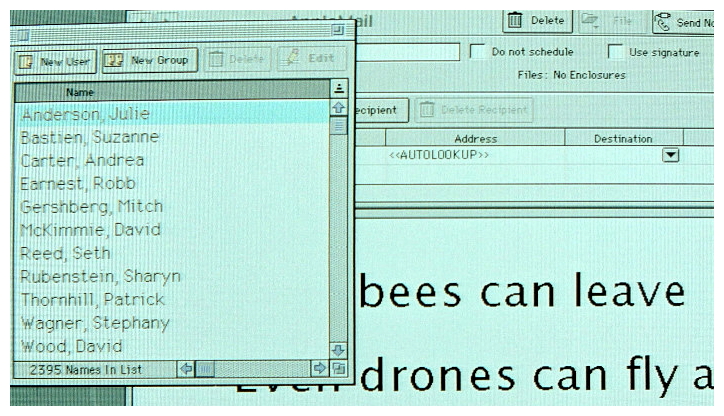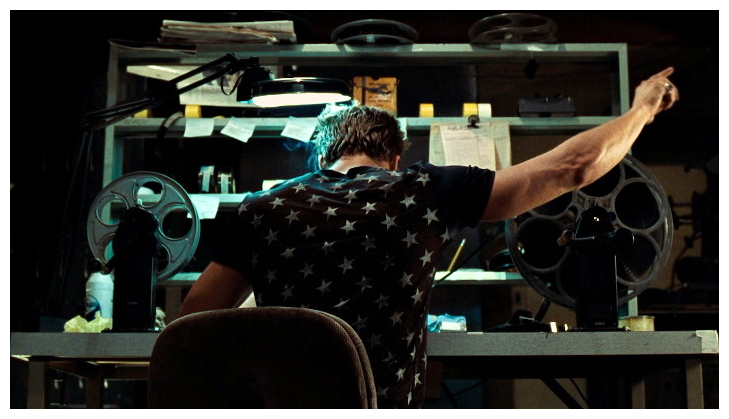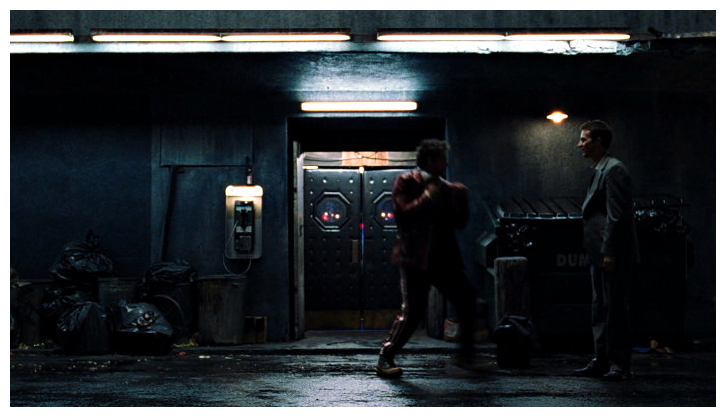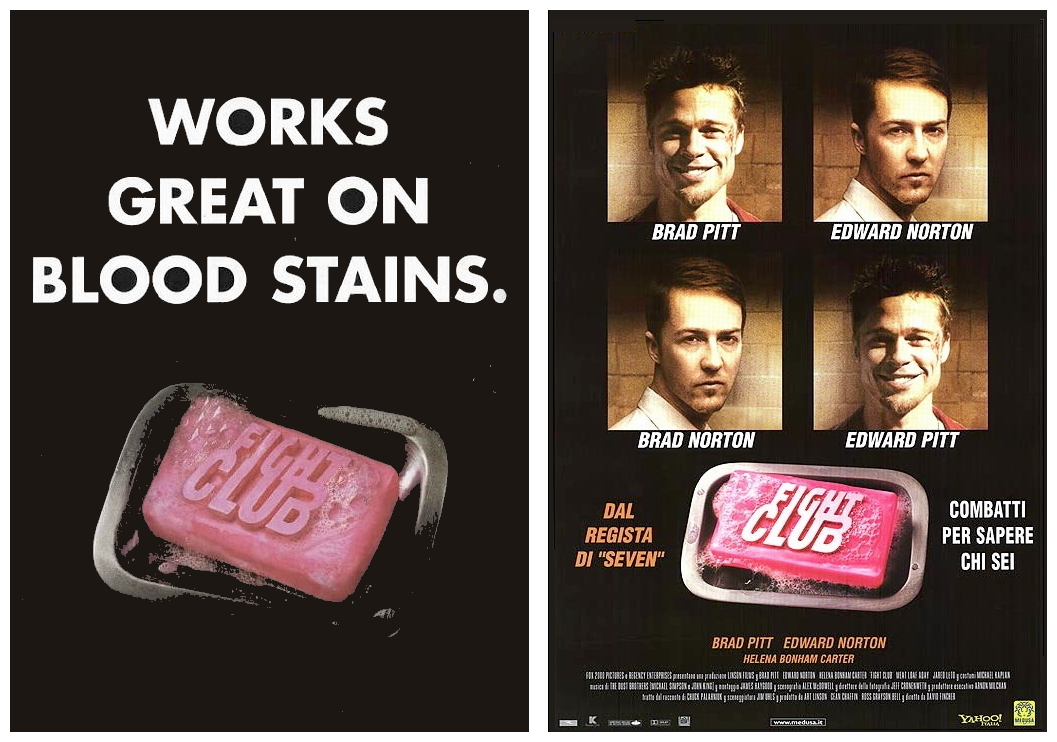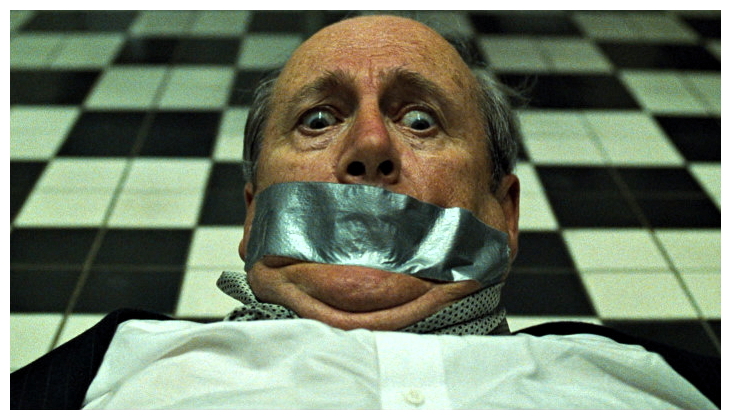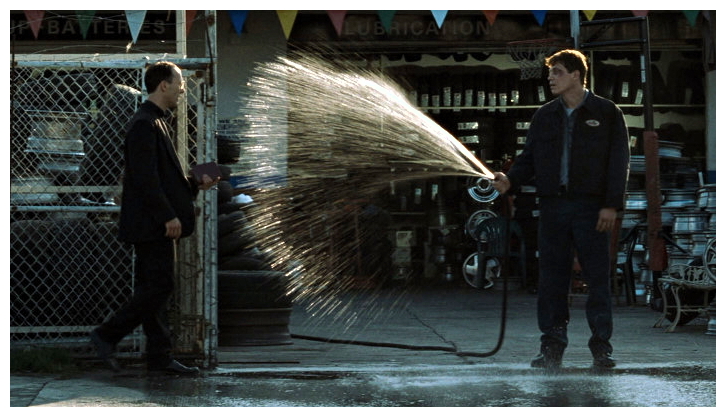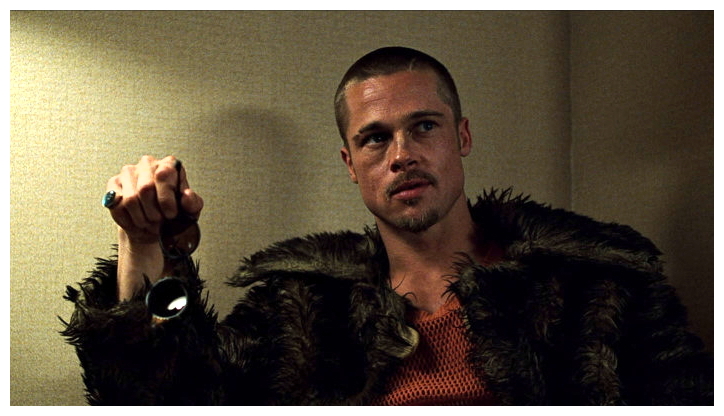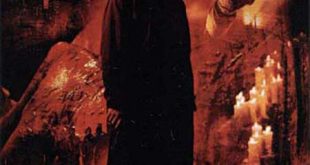SYNOPSIS:
“A young urban professional who works for a major car manufacturer can’t sleep. Although he doesn’t have any of the associated afflictions, he stumbles across support groups as a means to let out whatever emotions he is feeling, which in turn is allowing him to sleep. But the use of these support groups is ruined when he meets a young woman named Marla Singer, who is also going to all these support group meetings. Because he knows she too is not afflicted with any of the maladies for which the groups exist, her presence has lessened the impact of the stories he hears. His life changes when he meets a soap manufacturer named Tyler Durden, who in many ways is the antithesis of the insomniac. Due to unusual circumstances with his own condo, the insomniac moves in with Tyler, who lives in a large dilapidated house in an otherwise abandoned part of town. After a bit of spontaneous roughhousing with Tyler in a bar parking lot, the insomniac finds it becomes a ritual between the two of them, which is helping him cope with the other more difficult aspects of his life. The fights also attract a following, others who not only want to watch but join in. Understanding that there are other men like them, the insomniac and Tyler begin a secret fight club. As the fight club’s popularity grows, so does its scope in all aspects. Marla becomes a circle not specifically of the fight clubs but of Tyler and the insomniac’s collectives lives. As the nature of the fight clubs becomes out of control in the insomniac’s view, the insomniac’s life, in association, is one where he no longer understands what is happening around him, or how he can get out of it without harming himself.” (courtesy IMDB)
REVIEW:
“First rule of Fight Club, you do not talk about Fight Club. Second rule of Fight Club, you do not talk about Fight Club.” So says Tyler Durden, the anarchistic leader of a band of misfits who, having forsaken the trappings of yuppiedom and the consumer-goods-driven lifestyle, seek truth and meaning at an elemental level – through pain. In the months leading up to the release of Fight Club (1999), the cast and crew seem to have taken Tyler’s directive seriously, diligently maintaining the secrecy in pre-release interviews and publicity. Such carefully guarded secrecy was understandable given the movie’s third-act revelations, its disturbing themes and shocking displays of violence, sure to stir up heated controversy so soon after the Columbine school shootings. Chuck Palahniuk‘s subversive 1996 novel was first discovered by 20th Century Fox executive Raymond Bongiovanni who sent it to production president Laura Ziskin. She loved the novel and asked the opinion of a studio script-reader who slammed the book, stating it could never be filmed, it was exceedingly disturbing, volatile, dangerous, and would make audiences squirm.
Despite the negative report, Ziskin went ahead with the project and looked for producers who might be willing to take it on. Joshua Donen and Ross Grayson Bell both immediately agreed to produce it, largely because of the highly critical report from the studio reader – every reason the reader gave for why the film couldn’t be made, was another reason to make it. Ziskin agreed, purchased the rights to the novel for US$10,000 and approved the project. Meanwhile, Raymond Bongiovanni, who discovered the material in the first place, died shortly before the project was green-lit, his obituary stating his final wish was that the novel be made into a film. Three directors were approached: Peter Jackson loved the novel but he was busy making The Lord Of The Rings (2001) trilogy. Danny Boyle loved the novel too but he was busy making The Beach (2000). Bryan Singer didn’t even reply or read the novel. The producers then turned to David Fincher, who was in post-production on The Game (1997). Donen and Bell had both been impressed with Fincher’s work on Se7en (1995) and thought he could bring something unique to the project. They were right.
The film’s unnamed Narrator (Edward Norton) is a traveling car company employee who suffers from insomnia. One night he visits a support group for testicular cancer victims, where they assume that he too is a victim, and he spontaneously weeps into the arms of another man, finding a freedom that euphorically relieves his insomnia. He becomes addicted to participating in various support groups, always allowing them to assume that he suffers what they do. He notices another impostor named Marla Singer (Helena Bonham Carter), and makes a deal with her to avoid attending the same groups. Later, on his return home from a business trip, he finds his apartment demolished by an explosion. He calls Tyler Durden (Brad Pitt), a soap salesman he befriended on the flight, and they meet at Lou’s Tavern where the Narrator agrees to move into Tyler’s large but somewhat neglected house.
One night, outside Lou’s Tavern, Tyler asks the Narrator hit him, which develops into a bare-knuckle street fight. They have more fights outside the tavern on subsequent nights, attracting crowds of men, so the fighting is moved to the tavern’s basement where they form a Fight Club, a regular opportunity to fight recreationally. At one point Marla overdoses on pills and calls the Narrator for help. He ignores her, but Tyler answers the call and saves her. Tyler and Marla become sexually involved, and Tyler warns the Narrator never to talk to Marla about him. More Fight Clubs form across the nation and Tyler forms an organisation called Project Mayhem, devoted to anti-materialism and anti-corporate behaviour. The Narrator complains to Tyler that he wants to be more involved in the organisation, soon after which Tyler suddenly disappears.
As Fight Club spreads across the country and its objectives are expanded to include attacks on sacred-cow institutions, Tyler’s true nature is called into question, as is the Narrator’s very sanity. When a member of Project Mayhem is killed during a sabotage operation, the Narrator tries to shut down the project and follows the paper trail left by Tyler. In one city, a Project member greets the Narrator as Tyler. The Narrator calls Marla from his hotel room and discovers that Marla also thinks he’s Tyler. The primary challenge in the transformation of Fight Club from literary to cinematic experience was depicting the way the Narrator views the world around him (a slightly off-centre state of reality) for which much of the imagery would have to be realised with special effects rather than through live-action photography. Luckily David Fincher was already well-versed in the arena of visual effects, having worked for Industrial Light & Magic as a cameraman, and had no doubts about using state-of-the-art technology as a means to solve this dilemma:
“Demonstrating the Narrator’s thought processes became an all-important part of my setup, those first forty minutes when audiences are taught how to watch the film. Providing a mind’s-eye-view would help audiences understand the way the story was being told. We wanted an incredibly myopic framework, one that was valid given our intent to tell the story from the viewpoint of this particular guy, who turns out to be crazy. We wanted to leap out-of-body, moving the camera in a very free way to visualise his all-over-the-place thoughts as he tries to work things out for himself. Chuck Palahniuk‘s novel is written in a funny but clinical style in which the Narrator provides various recipes for disaster: This is how you make nitroglycerin; here is the formula for napalm. I needed to zip right through the Narrator’s verbal diarrhoea and, to do this, I decided to illustrate his asides in a way that brought out the menace of these everyday found objects. This approach used camera moves and effects to complement his voiceover, taking hold of the audience by their eyeballs, providing a frantic, slightly otherworldly quality.”
While at ILM Fincher worked on Star Wars VI Return Of The Jedi (1983) and Indiana Jones And The Temple Of Doom (1984), then moved on to big-budget television commercials for Converse, Nike, Coke, Pepsi, Revlon, Chanel and others. Then Fincher discovered MTV and directed a bunch of music videos including Madonna‘s Express Yourself, Vogue, Bad Girl, and Oh Father (featuring actor Joe Morton as a Christ-figure). His first feature film, Alien 3 (1992), did not go down too well with critics nor audiences when first released due to (according to Fincher) budget restraints, constant re-writes and the producers themselves for not having enough faith. After this particularly appalling experience, it’s no wonder he retreated back into the world of commercials and music videos but, a few years later, all was forgiven when he released Se7en (1995), about a serial killer inspired by the seven deadly sins, which took more than $300 million at the box-office. The Game (1997) starring Michael Douglas was critically acclaimed but largely dismissed by moviegoers as a rather mediocre exercise in paranoia.
Fight Club was one of the most controversial films of the nineties and, like some other movies released that same year – Magnolia (1999), Being John Malkovich (1999), Three Kings (1999) – it was recognised for its innovations in cinematic style and new developments in filmmaking technology. After Fight Club ’s initial theatrical release it became even more popular via word-of-mouth, and the positive reception of the DVD established it as a cult film. In 2006 the respected British magazine Total Film voted Fight Club #4 in their Hundred Greatest Movies Of All Time, outranked only by Jaws (1975), Vertigo (1958) and Goodfellas (1990). With astonishing camera and special effects work, Fight Club moves at a fast pace, resulting in an exciting, distressingly inspiring movie that makes even the strangest event seem perfectly normal, not least being Meat Loaf as a cancer patient with enormous mammary glands. I’ll leave you this uncomfortable image in mind, but not before thanking Cinefex #80 for assisting my research for this article. Please join me again next week as we step up to Hollywood’s all-you-can-eat buffet and fill our plates with public domain potato salad next week for…Horror News! Toodles!
Spoilers Ahead! 25 Clues To Tyler Durden’s True Identity In Fight Club (1999). This is not meant to be a complete list (and certainly not one you may necessarily agree with) but a rundown of the most obvious onscreen hints given to us by director David Fincher, some rather obvious, some you may not have noticed before.
1. When the Narrator gets on the bus with Tyler, he pays the fare for only one person.
2. Tyler’s job as a projectionist suggests that he himself is a projection of the Narrator.
3. When Marla leaves the Narrator’s house for the first time, he says that it’s his house and not Tyler’s.
4. At the airport the Narrator says, “Could you wake up as a different person?” just as the camera catches Tyler.
5. When Tyler calls back the Narrator in the phone booth, a sign can be seen stating ‘No Incoming Calls Allowed’.
6. When the airport valet lends them a car, he is looking directly at the Narrator when he addresses, “Mister Durden.”
7. When the pair are fighting outside Lou’s Tavern, no one in the gathering crowd intervenes, but instead look rather confused.
8. When entering Lou’s Tavern, the man out the front only acknowledges the Narrator, as though Tyler doesn’t even exist.
9. When the Narrator enters the house, just before seeing the ‘Happy Face’ news report, he’s carrying a Project Mayhem folder.
10. When the pair hit the car with baseball bats, Tyler hits first, but the alarm is triggered only after the Narrator hits.
11. When the pair are on the bus, a long-haired man pushes past Tyler silently then says, “Excuse me,” as he pushes past the Narrator.
12. The phone number on the back of Tyler’s business card (555-0178) is the Narrator’s previous home phone number.
13. Tyler’s soap company is called Paper Street, a common term for a street that has yet to be built, a street that doesn’t exist.
14. The Narrator roams the house while Tyler and Marla are having noisy sex upstairs but, when the Narrator answers the phone, the noises cease immediately.
15. Before the car crashes, Tyler was driving yet, after the crash, Tyler pulls the Narrator out through the car’s passenger side.
16. When going to the convenience store, Tyler gets a gun out of the Narrator’s backpack. The Narrator is surprised, despite the fact that it’s his backpack.
17. After the Narrator leaves Marla’s apartment he walks past a wall with the words ‘I Like Myself’ written repeatedly.
18. Tyler is often seen wearing Blue-Blockers, a specific brand of sunglasses commonly used by insomniacs to filter out blue light.
19. When the Narrator is fighting himself in his manager’s office, he says he’s reminded of his first fight with Tyler and, in the same scene, he throws himself against the bookshelf revealing the title of a book entitled ‘Anger Kills’.
20. The Narrator hears the support group leader begin his speech by saying, “I look around this room and I see a lot of…” Tyler uses the exact same phrase when he makes his big ‘Middle Children Of History’ speech.
21. After the car crash, the Narrator has a bruise on his head, but when the Narrator wakes up the ‘next morning’ the bruise is completely gone. This indicates more time has passed than just one night, and he was actually busy setting up Fight Clubs nationwide.
22. After the Narrator finds his apartment a ruin, he deposits a coin into the pay phone and calls Tyler. In the next scene as the the pair leave the bar, Tyler reaches into the coin return slot and retrieves the coin – it had never been spent.
23. When Lou punches Tyler in the stomach you can see the Narrator double over slightly as if he too was punched. Lou then kicks Tyler in the face and, in the background, we see the Narrator’s head go back at the moment of impact.
24. On the plane, the Narrator asks Tyler his name, but the Narrator never offers his own name, nor is he asked. In the same scene, the Narrator mentions that they have the exact same briefcase. Tyler opens his, but we never see the contents of the Narrator’s briefcase.
25. Tyler appears five times before we clearly see him at the airport, and only when the Narrator is suffering insomnia. Four times he flashes onscreen for a single frame: at the photocopier; outside the doctor’s office; at a group meeting; and when Marla is seen leaving a meeting. Tyler can also be seen as a waiter in the hotel’s introductory video. Fincher also wanted to include a single frame of Tyler during the 20th Century Fox logo but they wouldn’t allow it, then he asked co-producers Regency Enterprises, and they also refused.
Fight Club (1999)
 Horror News | HNN Official Site | Horror Movies,Trailers, Reviews
Horror News | HNN Official Site | Horror Movies,Trailers, Reviews
